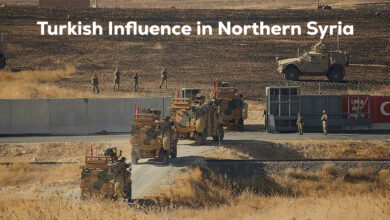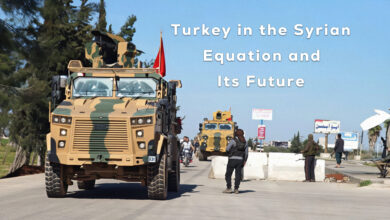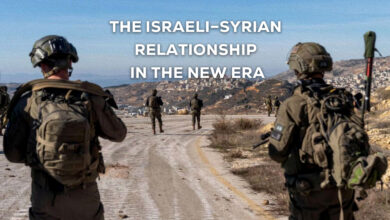Syria and the return to square one
At the beginning of the twentieth century and with the escalation of the struggle between various powers seeking dominance over the region, and as some of these countries reached the stage of decline (such as the Ottoman Empire), it became necessary to ignite the spark of World War I (1914-1918) and to rebuild the regional and international system according to their plans and strategies. To avoid any direct confrontation among themselves after the war, the powerful victorious countries in advance at that time (Britain, France, Italy, the Soviet Union, and also the participation of America) held many secret and public meetings before, during, and after the war. These ultimately led to the division of the Middle East among themselves and the establishment of nation-states. Thus, the Syrian state emerged, which was allocated to the French, who applied their policies in the Middle East, by dividing it into several states: the State of Damascus (1920), the State of Aleppo (1920), the State of the Alawites (1920), the State of the Druze Mountain (1921), Greater Lebanon (1920), and the Alexandria Independent Brigade (1921)[1]. Meanwhile, the regions of the Al-Jazeera, especially northern and eastern Syria, were under direct French control.
This policy and style of governance continued from 1936 to 1940, only to collapse later due to the waning influence of the French following severe blows during World War II by Nazi Germany, which contributed to ending their occupation of Syria in 1946. Despite Syria’s declaration of independence and its attempts to build a democratic system, this did not succeed, leading to a series of military coups. After the political process became obstructed in Syria, nationalists attempted to unify with Egypt in 1958 to overcome the crisis, but this did not last long, resulting in a separation. Following that, there was another coup led by the Ba’athists in 1963, who imposed martial law and a state of emergency[2] to manage the country. Then came the second Ba’ath coup in 1971, establishing a totalitarian regime in Syria under the current Syrian government. With the failure of this regime to resolve the country’s issues and its repressive domestic policy, the situation erupted again in March 2011, leading the country into a spiral of violence, chaos, and destruction. The country entered a state resembling a new division, as if it had returned to its initial square.
This state of regression is related to several objective and subjective factors concerning the current geopolitical situation in Syria. The objective factors pertain to the competing agendas of the effective countries involved in the Syrian crisis and their desire to create areas of influence belonging to them. As for the subjective factors, they are connected to the rise of hate speech among local forces to dangerous levels due to racist, nationalistic, and religious ideologies. In this stage, the Turkish system was prominently present, especially its negative stance on the Kurdish issue. Throughout the Syrian crisis, the Kurds have been threatened with slaughter and displacement, with the latest threats coming from Turkey but articulated by Syrian figures, specifically by its mercenaries known as the “National Army,” indicating the difficulty of coexistence among proponents of these extremist ideologies.
The features of this scene – the country’s return to square one – began from the first day of the Syrian crisis, but it increased significantly with the support of international and regional powers for the local conflict parties, with some of them starting direct intervention to support their ally, while others occupied the region to ensure their continued presence in this geography and even to remain there if the opportunity arose, like Turkey, which is among the most eager countries to divide Syrian territory and form a loyal state within it or to carve out parts of it and annex them to Turkey, similar to Alexandria Brigade.
Generally, insistence on something is often contrary to the fundamental demand and goal, and this can be generalized to the regional and international active forces in the Syrian crisis, which have not issued a statement without the phrase “preserving Syria’s sovereignty and preventing its division.” However, observing their practices on the ground will clarify that each party does not want stability in Syria, but rather to expedite demographic change processes and entrench political division. For instance, several clear indicators can be mentioned as evidence of international and regional policies aimed at entrenching division; the first is the public exchanges between Russia, Turkey, Iran, the Syrian regime, and its opposition in Astana and Sochi. The acceptance of all these parties, including America, of the Turkish occupation is a clear indication of moving toward this reality. The “green buses” policy and the exchanges occurring in Ghouta and southern Syria are closely related to this matter; those who refused to reconcile with the regime were sent back to their supportive environment in Idlib, and some were settled in Afrin after displacing its residents.
Secondly, the understandings between Kerry and Lavrov in 2015 and 2016 * regarding the crisis in Syria, reaffirmed again in 2018 after a meeting between Putin and Trump in Helsinki, which may still be in effect today with some urgent changes, especially following the Russian invasion of Ukraine, which may fall within the framework of dividing areas of influence among them and establishing a mechanism to avoid collision.
Thirdly, the agreement reached between Israel, America, and Russia in Jerusalem in 2019, with indirect participation from Jordan, focused specifically on Iranian presence, especially Hezbollah elements near the Israeli and southern Syrian borders, which led to the withdrawal of the mentioned powers by 85 km; however, this did not happen as required and their presence there continued. The ongoing tensions in southern Syria and in western Euphrates, particularly in Aleppo, can be attributed to an international consensus on the latest scene in Syria.
The recent events in Aleppo contradicted everyone’s expectations regarding the recovery of the Syrian regime and the opposition’s acceptance of significant concessions. The crisis has entered a new political phase that may signal the beginning of dividing the country’s geography into several areas, similar to its initial formation during the French mandate; these areas can be defined without specifying their geographical borders, as field events are developing daily and the control map is changing from time to time. Therefore, these areas can be identified as follows:
- An area ruled by Bashar al-Assad with Russian support, primarily located in Latakia, Tartus, Homs, and Damascus.
- An area under Turkish hegemony and governed by various Islamic opposition factions, with Aleppo as its stronghold, where the terrorist-designated al-Jolani visited yesterday without fear of any targeting; he even declared from its citadel that he would dissolve his movement and transfer the administration of the area to a transitional council, which suggests the existence of international, Arab, and Turkish understandings to rehabilitate the movement in exchange for certain demands, the most notable of which is renouncing its ideology and dissolving itself, in addition to other understandings that will become clear upon reaching new agreements and halting the fighting.
- An area in northern and eastern Syria managed by all components, including Kurds, supported by the international coalition, particularly America, which played the role of mediator in the understandings between Hayat Tahrir al-Sham and the Syrian Democratic Forces in the west Euphrates area, which has been described in some aspects as strategic understandings. It also played a role in preventing major violations against the Kurds in the west Euphrates area ** following its communication with Turkey and its mercenaries.
New areas of influence may emerge, especially in the southern Syrian region, which is witnessing ongoing tensions that may lead to Israel carrying out a ground military operation there in cooperation with Jordan and the factions operating there, provided that it is managed in a security manner that guarantees Israel’s security. The acceleration of events in those regions is related to the Iranian presence and the nature of their behavior, which will most likely be subject to close monitoring by Jordan and Israel. Therefore, dramatic developments in that geography cannot be ruled out. In addition, the turbulent situation in the Suweyda region for several years and their establishment of a political council to represent them may have coincided with the start of the events in Aleppo, noting that their sheikhs have good relations with both Jordan and America.
What is happening in the Syrian arena can be described as geopolitical trade-offs in the region. The recent events in Aleppo are largely linked to what is happening in Gaza and Lebanon, the most prominent repercussions of which were the major crack in the Iranian strategy in the region as a result of the influential and successive strikes on it and its agents by Israel and the West, the latest of which was the exit of Aleppo from the control of its militias without any significant resistance, which indicates the existence of undeclared understandings between the parties to the conflict in Syria, led by America, which seems to be proceeding with achieving its strategy in the Syrian arena, part of which was announced by Pompeo (former US Secretary of State) in 2019 by focusing on eliminating ISIS and expelling the last Iranian soldier from Syrian territory[3] and implementing international resolution 2254.
Based on the changes taking place in the security and political scene of the crisis on the Syrian scene, the occupying Turkish state will seek to extend its military operations to the regions of northern and eastern Syria, but this depends largely on the understandings reached between the parties. Despite this, developments seem to be accelerating, which casts ambiguity on the future of the country. However, the final scene for Syria may be in the form of areas of influence based on the agreements and understandings reached since the beginning of the crisis and consistent with the policies of the participating countries that will not give up their interests and agendas to the other parties. Therefore, reaching understandings between them will determine the shape of the future Syria, which seems to be heading to its first square, noting that the regions of northern and eastern Syria have tried a lot to bridge the gap between all Syrian regions through their ongoing initiatives, but they have not received positive responses because everyone wants to implement their agendas that will lead the country to further division.
- References:
[1] Encyclopedia of Knowledge, French Mandate over Syria, Publication Date Not Available, Electronic Link: https://www.marefa.org/%D8%A7%D9%84%D8%A7%D9%86%D8%AA%D8%AF%D8%A7%D8%A8_%D8%A7%D9%84%D9%81%D8%B1%D9%86%D8%B3%D9%8A_%D8%B9%D9%84%D9%89_%D8%B3%D9%88%D8%B1%D9%8A%D8%A7
[2] The Political Encyclopedia, Abdul Rahman Osama, published in 2020, electronic link: https://politicalencyclopedia.org/dictionary/%D8%A3%D8%AD%D9%83%D8%A7%D9%85%20%D8%B9%D8%B1%D9%81%D9%8A%D8%A9
* According to many analysts and political observers, the meeting between Lavrov- Kerry in 2016 lasted for ten hours, which is a very long time, which indicates that they agreed on the broad outlines of the solution path in Syria, including the fate of Bashar al-Assad and how to confront ISIS, the Iranians, and others. It is also believed that the emergence and circulation of the term “East of the Euphrates” and “West of the Euphrates” came out during these meetings.
** According to many analysts of the Kurdish issue, there was a plan by Turkey and its mercenaries to commit massacres against the Kurds in the west of the Euphrates, but Blinken’s communication with Turkey prevented massacres against the Kurds there, noting that a number of violations were committed against some Kurdish families while they were leaving their areas.
[3] France Press website, Pompeo confirms that Washington will work through “diplomacy” to “expel the last Iranian soldier” from Syria, published in 2019, electronic link:




